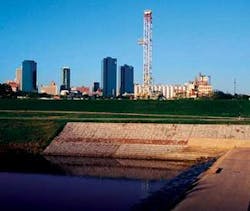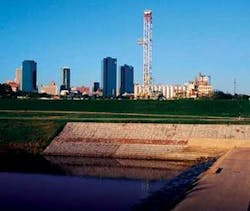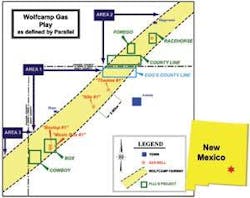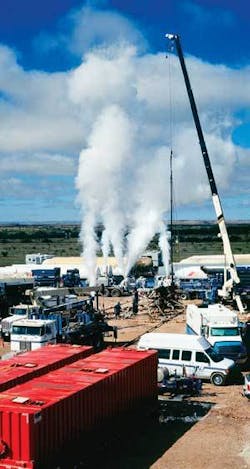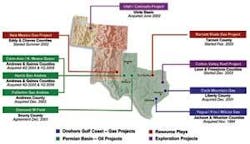AN INTERVIEW WITH LARRY OLDHAM: West Texas operator expanding its reach
OIL & GAS FINANCIAL JOURNAL: Looking at Parallel Petroleum’s (PLLL’s) history since it was formed in 1979, are you still operating in pretty much the same geographical areas and basins that you started out in 27 years ago or has the company expanded into other areas? What is the company’s thinking on this?
Don Stowers - Editor, OGFJ
EDITOR’S NOTE: Larry Oldham, president and CEO of Parallel Petroleum, agreed to talk with OGFJ about the company he heads and how a change in business strategy has helped the company’s market value grow from a little over $100 million in 2003 to nearly $1 billion today. Larry was one of the company’s founders in 1979 and became CEO in 2004. He was appointed president in 1994, and before that served as executive vice president. Previously, he was employed by Dorchester Gas Corp. and KPMG Peat Marwick.
OIL & GAS FINANCIAL JOURNAL: Looking at Parallel Petroleum’s (PLLL’s) history since it was formed in 1979, are you still operating in pretty much the same geographical areas and basins that you started out in 27 years ago or has the company expanded into other areas? What is the company’s thinking on this?
LARRY OLDHAM: We continue to focus on the Permian basin. However, our business model changed in June 2002 to an acquire-and-exploit model versus an exploration model. This change was brought on by our acquisition of the Fina assets for $96 million in the summer of 1999. We subsequently sold those assets to Energen for a net gain of more than $100 million. PLLL’s share of the gain was approximately $32 million, so we took the $32 million and the key people out of the Fina transaction and brought them to PLLL, changed the business model, and here we are today.
Our stated goal in June 2002 was to double the net asset value of the company in 3 years, position PLLL to be a top-quartile performer in its peer group, and to become a preferred operator and employer in Midland, Texas - our home and headquarters. We have achieved all of these goals.
OGFJ: What are the pros and cons of diversifying - that is, operating in a variety of regions, plays, etc.?
LO: We focus on quality assets. Our first focus was to acquire long-life Permian oil assets with infill, secondary, and tertiary potential. The assets we acquired are the Carm-Ann San Andres field in Andrews and Gaines counties; the Harris San Andres property, also in Andrews and Gaines counties; the Diamond M Canyon Reef field in Scurry County; and the Fullerton San Andres field in Andrews County. Then we wanted to find some nice gas projects to complement our oil base, and our evaluation led us to the Barnett shale and the Wolfcamp gas project in New Mexico. We focused on quality and applied our teams’ skill sets.
OGFJ: Parallel is strictly an onshore company, and I believe all your operations are in the United States. Would you consider operating overseas, or in Canada for instance, if the right opportunity came along? How about offshore?
LO: No. We like staying onshore and close to home. We are staying very focused.
OGFJ: After hearing your presentation at the EnerCom Oil & Gas Conference in Denver in August and later at the IPAA’s OGIS West Conference in San Francisco this past October, I was impressed with Parallel’s dramatic growth - especially in production volumes and reserves replacement. How do you account for these increases?
LO: Our team has and continues to focus on quality assets that have low-risk infill development potential. We prefer large chunky assets where we can control the timing of expenditures and increase the daily production volumes without taking a lot of risk. Also, the emerging gas projects that we have are really good.
Our Barnett shale gas project is in the core area and is considered to be in the “Sweet Spot.” Our wells are truly in the top 10% of the wells drilled in the Barnett shale. Our New Mexico project is in the emerging stage of development. We have some fantastic wells, and we have some weak wells. The trend is approximately 50 miles long and 10 miles wide. We have 3 areas that we own interests in, 2 of which we operate. We own approximately 56,000 net acres in the project and expect it to be drilled on a 160-acre spacing. A very exciting project.
OGFJ: Will the rise in production volumes this year translate into greater profitability for the company? How is 2006 shaping up in terms of revenues and profits compared with recent years?
LO: 2006 will be a record year in all categories of production, earnings, net cash flow, and capital expenditures.
OGFJ: Speaking of capital expenditures, PLLL had an aggressive capital investment budget in 2006. Has this paid off for the company?
LO: Production volumes are up 43%, 3Q06 versus 3Q05. Reserve volumes are up 18% over year-end 2005 versus 9/06. I think this speaks for itself.
OGFJ: What can you tell our readers about fiscal 2006 financial results?
LO: Our third-quarter net income for 2006 was $11 million compared to $2 million for the comparable quarter last year. Nine-month income as of Sept. 30 was $15 million versus $10.2 million last year.
OGFJ: What are your projections for 2007?
LO: We expect to have a 1Q2007 budget of $42 million, and 80% will be invested in the two emerging resource gas projects - New Mexico Wolfcamp and the Barnett shale.
OGFJ: How much of your production is hedged? Can you elaborate on this?
LO: The bank requires that we have at least 50% of our production hedged. Right now, our primary hedges are related to oil - and very little gas. We primarily deal in collars now. Historically, we dealt in swaps in order to maximize our loan value.
OGFJ: Has Sarbanes-Oxley compliance been difficult for PLLL? Any thoughts on Sarbox you’d care to share?
LO: It’s very expensive and tough on small companies. I think that a lot of small and large companies that are thinking about going public will go to Europe and go public via the AIM and bypass all of the SOX 404 issues.
OGFJ: Parallel has begun operating in unconventional plays in the Barnett shale and in the New Mexico Wolfgang project. Does drilling in shale or tight gas formations present any particular technical challenges for you?
LO: The technical challenge is to develop the best operating practices for the drilling and completion. The drilling must be in the right direction because of natural fracture orientation. Drilling fluids, correct pumps, bits, and mud motors vary by areas. Then, the proper recipe for stimulation is always a challenge. You don’t know until you know, and we learn as we go. There is no magic bullet. However, the more you do, the more you learn.
OGFJ: Is rig availability a problem in any of the areas where PLLL operates? If so, what are you doing to work out the problem?
LO: We are not having any issues with rig availability. Our primary issue is pumping services related to our frac jobs in New Mexico.
OGFJ: Are you having any trouble hiring and retaining qualified and experienced employees, both professional staff and others? How are you tackling this problem?
LO: We have a fantastic team of skilled personnel and have had no turnover while implementing this business model. We implemented a Net Asset Value Plan whereby the employees will participate in the upside of the company when the company is sold. We do not have a date on the calendar when PLLL will be sold, but each employee must be with the company when it is sold to get their share of the NAV. PLLL is proof that incentive pay works. Just look at the company’s performance since June 2002.
OGFJ: Is there anything else you would like to say about the company’s operations and plans going forward?
LO: Well, I am 53 years old and I have been with PLLL over one half of my life. PLLL has the same phone number and post office box number that it started with in 1980. We have seen some pretty tough times, including the early ‘80s, 1986, and then the tough 1998-1999 years. Although it’s been a tough road, I am more excited today about the upside potential of the company than I have ever been, and it is directly related to our great team and their skill sets that I am associated with.
OGFJ: Thanks for taking time out to talk with us.
